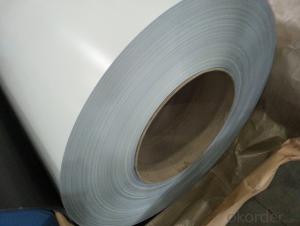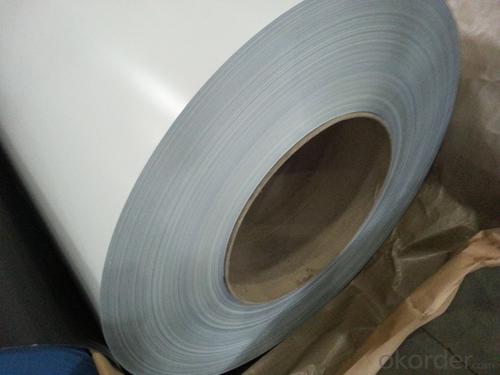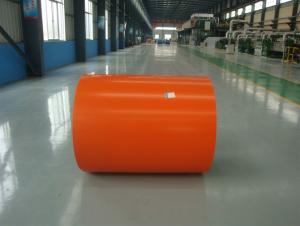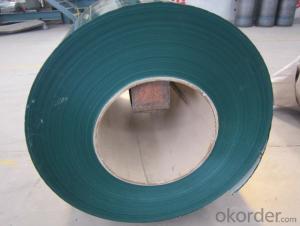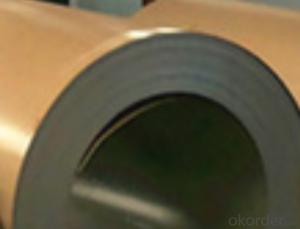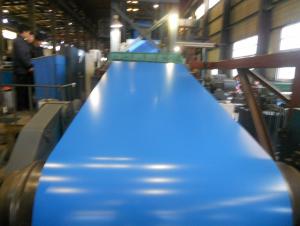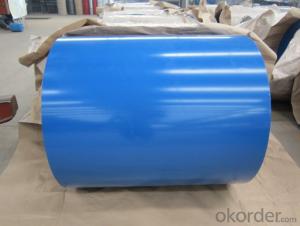Pre Painted Galvanised Steel Coil in roll
- Loading Port:
- Shanghai
- Payment Terms:
- TT OR LC
- Min Order Qty:
- 50 m.t.
- Supply Capability:
- 5000 m.t./month
OKorder Service Pledge
OKorder Financial Service
You Might Also Like
Pre Painted GALVANISED Steel Coil
Color pre painted steel in coil with various pattern like wood grain, brick grain, marble grain.
Pattern: can be customized according to customers requirements.
Suitable for indoor or outdoor decoration, color lasting for at least 10 years for outdoor using, could for roll forming.
Protective film can be provided according to customer needs.
Paint: PE or PVDF
Width and Thickness: width within 1250mm, thickness from 0.23-0.8
Color pre painted steel in coil
ZINC COATING:G30
TOP COATING:5 MIC EPOXY+20 MIC PE, PROTECTION FILM
BACK COATING: 7 MIC EPOXY GREY
WEIGHT PER COIL:3-8TONS COLOUR: RAL 9010 PURE WHITE
STANDARD:JIS G3312,CGCC
Package:Standard export seaworthy package:waterproof paper+steel trip packed+wooden case seaworthy package
Pre Painted Steel Coil is coated with organic layer, which provides higher anti-corrosion property and a longer lifespan than that of galvanized steel sheets.
- Q: How are steel coils used in the manufacturing of automotive parts?
- Steel coils are used in the manufacturing of automotive parts as they are shaped and formed into various components such as body panels, chassis frames, and suspension parts. The coils are processed through a series of steps including cutting, bending, and stamping, to create the desired shape and size for each specific part. These steel components provide strength, durability, and structural integrity to the automobiles, ensuring their safety and performance on the road.
- Q: How are steel coils protected during transportation?
- Steel coils are protected during transportation through various measures to ensure their safety and prevent damage. One common method is the use of high-quality packaging materials such as heavy-duty plastic wrapping or waterproof paper. These materials provide a protective barrier from external elements like moisture, dust, and debris. Additionally, steel coils are often placed on wooden pallets or skids to elevate them from the ground and prevent direct contact with surfaces that could potentially cause scratches or dents. To further safeguard the coils, they are securely strapped or banded to the pallets using strong, corrosion-resistant metal strapping or bands. This helps to keep the coils in place and prevent any movement or shifting during transportation, minimizing the risk of damage. Moreover, steel coils are often loaded and secured onto flatbed trailers or shipping containers using specialized equipment like coil cradles, coil racks, or coil bunks. These devices are designed to hold the coils firmly in place and distribute the weight evenly to avoid any stress or strain during transit. In addition to physical protection, steel coils may also undergo various surface treatments before transportation to prevent corrosion. This can include applying a protective coating or oiling the coils to create a barrier between the steel and the surrounding environment. This process helps to prevent rust or other forms of corrosion during transit, especially when the coils are exposed to adverse weather conditions or long shipping durations. Overall, a combination of proper packaging, secure strapping, and appropriate loading techniques are employed to protect steel coils during transportation, ensuring their safe arrival at their destination without any significant damage.
- Q: What are the different methods of testing the mechanical properties of steel coils?
- There are several methods for testing the mechanical properties of steel coils. Some commonly used methods include tensile testing, hardness testing, impact testing, and bend testing. Tensile testing measures the strength and ductility of the steel by applying a tensile force until it breaks. Hardness testing determines the resistance of the steel to indentation or scratching. Impact testing measures the ability of the steel to withstand sudden forces or shocks. Bend testing evaluates the flexibility and resistance to cracking of the steel by bending it to a specific angle. These methods help assess the quality and performance of steel coils in various applications.
- Q: What are the different methods of stretch leveling steel coils?
- There are several methods of stretch leveling steel coils, each with its own advantages and applications. 1. Roller Leveling: This method involves passing the steel coil through a series of rollers that apply pressure to stretch and flatten the material. It is a widely used method for leveling steel coils and offers good control over the leveling process. Roller leveling is suitable for thin and medium gauge steel coils. 2. Tension Leveling: In this method, the steel coil is subjected to high tension forces applied by a set of bridle rolls. The tension helps to elongate and flatten the material, resulting in a level and stress-free coil. Tension leveling is particularly effective for thicker and harder steel coils. 3. Laser Leveling: Laser technology is employed in this method to measure and correct any imperfections in the steel coil. A laser scanner scans the surface of the coil and detects variations, which are then adjusted by a laser beam. Laser leveling offers high precision and is suitable for leveling sensitive and high-value steel coils. 4. Stretcher Leveling: This method involves stretching the steel coil beyond its yield point, which causes the material to permanently deform and eliminate any residual stresses. Stretcher leveling is commonly used for heavy gauge coils and can achieve significant flatness improvements. 5. Tensionless Leveling: As the name suggests, tensionless leveling is performed without applying tension to the steel coil. Instead, hydraulic or pneumatic pressure is used to stretch and flatten the material. This method is suitable for delicate or sensitive steel coils that may be prone to damage under high tension forces. Each method of stretch leveling steel coils has its own advantages, such as control, precision, or suitability for specific types of steel coils. The choice of method depends on factors like the thickness, hardness, and quality requirements of the steel coil, as well as the desired flatness and surface finish.
- Q: How are steel coils inspected for defects?
- Steel coils are inspected for defects using various methods to ensure that the quality of the product meets the required standards. One common method is visual inspection, where trained inspectors examine the surface of the coils for any visible defects such as cracks, scratches, or dents. This is usually done by visual observation or with the assistance of magnifying tools. Another method is magnetic particle inspection, which is used to detect surface and near-surface defects such as cracks or voids. In this process, a magnetic field is applied to the steel coil, and a magnetic powder is applied to the surface. If there are any defects, the magnetic powder will be attracted to them, making them visible to the inspector. Ultrasonic testing is also commonly used to inspect steel coils for defects. In this method, high-frequency sound waves are transmitted into the coil, and the reflected waves are analyzed. Any deviations in the sound waves can indicate the presence of defects such as cracks or voids within the coil. Additionally, eddy current testing is employed to detect defects in steel coils. This method uses electromagnetic induction to generate eddy currents within the coil. Any changes in these currents caused by defects in the material are detected and analyzed by the inspector. Lastly, some steel coils may undergo destructive testing, where a sample is taken from the coil and subjected to various tests such as tension or bend testing. These tests are performed to evaluate the mechanical properties of the steel, which can indirectly indicate the presence of defects. Overall, steel coils are inspected for defects through a combination of visual inspection, magnetic particle inspection, ultrasonic testing, eddy current testing, and potentially destructive testing. These methods ensure that any defects are identified and addressed, ensuring that only high-quality steel coils are delivered to customers.
- Q: How do steel coils affect the quality of finished products?
- The quality of finished products in various industries can be greatly influenced by steel coils. Dimensional accuracy and consistency are key factors that determine the impact of steel coils on product quality. When steel coils are not properly manufactured or have irregular dimensions, it can cause issues in the production process and result in finished products that do not meet the desired specifications. Moreover, the final appearance and performance of finished products are heavily dependent on the surface quality of steel coils. Defects such as scratches, rust, or unevenness in the coils can have a negative impact on the aesthetic appeal of the products, making them less desirable to customers. Additionally, these defects can compromise the functionality and durability of the finished products, potentially leading to failures or a reduced lifespan. The mechanical properties of steel coils also play a crucial role in determining the quality of finished products. Coils with inconsistent or inadequate mechanical properties can compromise the strength, toughness, and overall performance of the end products. This is especially important in industries like automotive or construction, where strength and reliability are of utmost importance. The use of steel coils with incorrect mechanical properties can lead to safety hazards or structural failures. Furthermore, the chemical composition of steel coils can have a significant impact on the quality of finished products. The presence of impurities or variations in the alloying elements can affect the material's corrosion resistance, weldability, and other important properties. This, in turn, can affect the longevity and functionality of the final products. In conclusion, steel coils have a significant influence on the quality of finished products. Their dimensional accuracy, surface quality, mechanical properties, and chemical composition all contribute to the overall performance, appearance, and durability of the end products. Therefore, it is essential to ensure that steel coils used in manufacturing processes meet the required standards to achieve high-quality finished products.
- Q: What are the potential dangers of handling steel coils?
- There are several potential dangers associated with handling steel coils. Firstly, steel coils are heavy and can pose a risk of physical injury if not handled properly. The weight of the coils can cause strains, sprains, or even more serious injuries if dropped or mishandled. This is particularly true when using manual lifting equipment or when attempting to move the coils without proper training or assistance. Secondly, steel coils often have sharp edges or protruding parts that can cause cuts or puncture wounds if not handled with care. These sharp edges can be especially hazardous when attempting to manipulate or position the coils during transportation or storage. It is important to wear appropriate personal protective equipment, such as gloves, to minimize the risk of injury. In addition, steel coils can become unstable if not adequately secured or balanced. Improper stacking or storage of the coils can lead to them shifting or falling, potentially causing serious injuries or damage. It is crucial to follow proper stacking and storage procedures, including using appropriate equipment and supports, to ensure stability and prevent accidents. Furthermore, steel coils are often stored in areas with limited space or uneven surfaces, increasing the risk of trips, falls, or collisions. It is essential to maintain clear and well-organized storage areas, free of obstacles or hazards, to reduce the likelihood of accidents. Lastly, steel coils can be subject to corrosion or rust, which can weaken the metal and compromise their structural integrity. This can increase the risk of the coils collapsing or breaking during handling, potentially causing injuries or damage to property. Regular inspections and maintenance of the coils, as well as proper storage in dry and well-ventilated areas, can help mitigate this risk. Overall, the potential dangers of handling steel coils include physical injuries from their weight and sharp edges, instability during transportation or storage, accidents due to limited space or uneven surfaces, and the risk of structural failure due to corrosion or rust. It is crucial to follow proper safety protocols, receive appropriate training, and use the necessary equipment to minimize these risks and ensure safe handling of steel coils.
- Q: What are the different methods of coil slitting for precision cuts?
- Coil slitting is a process used to cut large coils of material, such as steel, into narrower strips with precise dimensions. There are several methods of coil slitting for achieving precision cuts, each offering unique advantages and suitable for different applications. 1. Rotary Shear Slitting: This is the most common method used for coil slitting. It involves passing the coil through rotating circular knives that create two or more strips by shearing the material. The blades can be set at different distances apart to achieve the desired width of the strips. Rotary shear slitting offers high precision and is capable of producing smooth, burr-free edges. 2. Drag Knife Slitting: In this method, a knife with a drag or tangential orientation is used to cut the coil. The knife moves in a controlled path, following the contour of the material and producing accurate cuts. Drag knife slitting is suitable for materials with irregular shapes and is often used in the textile industry for cutting fabrics. 3. Scissor Slitting: Scissor slitting involves the use of two blades that move against each other in a scissor-like motion to cut the coil. This method is commonly used for thinner materials and provides excellent control over the cutting process. Scissor slitting is ideal for achieving precise cuts in materials that are prone to deformation or wrinkling. 4. Razor Slitting: Razor slitting utilizes a single razor blade or multiple razor blades in a holder to cut the coil. The blade(s) are positioned perpendicular to the material and slice through it. This method is particularly effective for cutting stretchy or delicate materials, such as plastic films or paper, as it minimizes the risk of tearing or deforming the material. 5. Crush Cutting: Crush cutting involves using a hardened steel roller or an anvil against a softer material, such as foam or rubber, to cut the coil. The pressure applied causes the material to deform and split along the desired cutting line. Crush cutting is suitable for materials that are difficult to cut with sharp blades and can produce precise, clean cuts. Overall, the choice of coil slitting method depends on the material being cut, the desired precision, and other requirements of the specific application. Each method offers its own benefits and can be tailored to meet specific cutting needs, ensuring accurate and efficient coil slitting processes.
- Q: How are steel coils used in the manufacturing of automotive suspension systems?
- Steel coils are used in the manufacturing of automotive suspension systems as they provide the necessary support and stability to withstand the weight and movement of the vehicle. These coils are typically shaped into springs and installed in the suspension system to absorb shocks, maintain proper ride height, and improve overall handling and comfort for the driver and passengers.
- Q: What are the common uses of galvanized steel coils?
- Galvanized steel coils are commonly used in a variety of applications such as construction, automotive manufacturing, HVAC systems, electrical appliances, and roofing. The galvanization process provides corrosion resistance, making these coils ideal for outdoor structures, metal frames, and components that are exposed to moisture or harsh weather conditions.
Send your message to us
Pre Painted Galvanised Steel Coil in roll
- Loading Port:
- Shanghai
- Payment Terms:
- TT OR LC
- Min Order Qty:
- 50 m.t.
- Supply Capability:
- 5000 m.t./month
OKorder Service Pledge
OKorder Financial Service
Similar products
Hot products
Hot Searches
Related keywords
